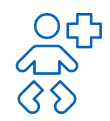Member Benchmarking Opportunities
The Network’s member work programme comprises of a wide range of benchmarking projects on topics covering but not limited to: Pharmacy, Outpatients, Virtual Wards, Children and Young People’s and Adult & Older People’s Mental Health. Members can look forward to engaging projects, interactive events and insightful data aimed at addressing key challenges and delivering opportunities across all sectors of the NHS. The member work programme is approved by the Network Steering Group following extensive consultations with the sector based Reference Groups and with members on the topics to be included in the programme.
Every member project produces: a benchmarking findings event, benchmarking project report, an online toolkit and a range of outputs including case studies.
Insight members receive engagement sessions, improvement opportunity reports, dedicated Network support and support packages which cover data quality, data interpretation and utilisation of data.
Download our 2025/26 membership brochure and 2025/26 member programme timetable.
Our projects are split into:
Indicators Projects/Products
Acute Indicators
Online dashboard using nationally available data for English Acute Trusts
An interactive dashboard is available for English Acute Trusts that offers a concise yet insightful overview of each Trust’s structure and performance, using data from nationally available sources. By benchmarking against all other Acute Trusts in England, this dashboard facilitates a deeper understanding of your Trust’s unique position, identifying both strengths and areas for improvement.
Emergency care waiting times
Elective care waiting times
Cancer waiting times
Diagnostic waiting times
Example metrics include:
Bed Occupancy
Mortality
Sickness absence
Staff leaver rate
Maternity Care inc. equitable access
Friends and Family Test responses
Monthly collection project
Community Indicators
Monthly data collection project for any providers of community services
This monthly data collection project includes over 40 metrics. Covering patient safety and quality, access, productivity, workforce and finance, to track ongoing changes in the delivery of community services, community hospitals and intermediate care. Participants are able to see how they compare to their peers each month, as well as seeing how their trend over time compares to the sample trend. PDF reports are produced monthly as well as the online data explorer.
Referrals received
Waiting times
Pressure ulcer acquired
Example metrics include:
Bed occupancy
DNA rates
Contacts delivered
Length of stay
Sickness absence
Vacancy rate
As well as other metrics including Cost Improvements Plans, use of virtual contacts, use of bank and agency staff, medication errors and falls.
Quarterly collection project
MHLDA Indicators
Quarterly data collection project for any providers of Mental Health services, reporting on monthly data.
This quarterly data collection project commenced in April 2020 as a COVID-19 dashboard, enabling participants to track the impact of the COVID-19 pandemic on mental health, CYPMHS and learning disabilities services, both within their organisation and in comparison to the wider UK dataset. The month-on-month data is collected quarterly, enabling participants to see month-on-month trends, for themselves and the sample.
Referrals received
Productivity measures
Waiting times
Example metrics include:
Caseload size
Bed occupancy rate
Discharge rate
Admission rate
Length of stay
Online dashboard using nationally available data for England.
The National Indicators data explorer draws from around 40 publicly available data sources, presenting the information in a series of easy-to-navigate charts. By bringing together multiple data sources, you are easily able to interrogate a range of data at once. The aim of the National Indicators Tool is to support healthcare leaders in developing strategic planning operational priorities such as quality improvement and transformation programmes.
National Indicators
NB. The tool currently includes majority English data, but we are working with colleagues in Wales to incorporate Welsh data, there are already a limited selection of metrics available. The hope is to include Northern Irish and Scottish data in the future.
The online interactive tool includes over 800 metrics.
Over 140 tags including:
Admissions
Appoints in GPs
Depression
Environment and Neighbourhood
Local Authority
Urgent Care
Mental Health
Data domains:
Capacity & Access
Finance
Quality & Outcomes
Population Health
Workforce
Activity
Key themes:
Children’s Health
Urgent Care
Cancer
Respiratory Conditions
Frailty
Integrated Primary Care
CORE20PLUS5
Annual Projects/Products
Community project for any providers of adult community services.
Adult community services have been benchmarked over many years by NHSBN. 2025 sees the introduction of a dedicated Adult Community Services project. Focusing on activity and workforce this project enables members to compare a selection of their key community services.
The services within the scope of this project are:
Adult/All-age Community Services Project
Cardiac
Dietetics
Musculoskeletal (MSK)
Occupational Therapy
Physiotherapy
Podiatry
Respiratory
Speech and Language therapy
Service users on caseload
Waiting time to 1st contact
Waiting time to 2nd contact
Examples metrics include:
Total contacts
Use of non-face-to-face contacts
Workforce size
Skill mix
Vacancy rate
Mental Health sector project for any providers of adult services.
The NHS Adult and Older People’s Mental Health Benchmarking Project tracks over 11,000 metrics, covering areas like inpatient care, community services, crisis support, and clinical outcomes. It helps mental health providers assess their performance in productivity, efficiency, quality, finances, and workforce.
Adult and Older People’s Mental Health Project
Referrals received
Referral acceptance rate
Waiting times
Example metrics include:
Admission rate
Bed occupancy
Length of stay
Workforce size
Skill mix
Vacancy rate
As well as patient demographics, activity, service model, finance, patient safety, and outcomes metrics.
Community project for any providers of children’s community services
We have benchmarked children's community services for many years, evolving through various projects. This year, we unify all children’s community services benchmarked in 2024 into the Children’s Community Services project. Giving participants insight into their community provision for children.
Children’s Community Services Project
The services within the scope of this project are:
0-19
Children’s Community Nursing
Dietetics
Health Visiting
Occupational Therapy
Paediatrics
Physiotherapy
School Nursing
Speech and Language Therapy
Referrals received
Referrals received over time
Waiting times
Example metrics include:
Caseload size
Total contacts
Mandated reviews
Workforce size
Skill mix
Vacancy rate
Mental Health sector project for any providers of children’s services
The project includes activity and workforce data for community and inpatient CYPMHS services. Community services covered include general, MHST, eating disorders, crisis, forensic, specialist teams, ASD, ADHD, and neurodiversity. Inpatient services include general admission (children and adolescents), eating disorders, PICU, low secure, medium secure, and others.
Children and Young People’s Mental Health Project
Referrals received
Waiting times
Caseload volumes
Example metrics include:
Admission rate
Bed occupancy
Length of stay
Workforce size
Skill mix
Vacancy rate
As well as activity, service model, finance, digital, and outcomes metrics.
Community project for any providers of district nursing services
District Nursing has been benchmarked by the Network for over 10 years, most recently as a standalone project, providing a focused deep dive into district nursing services, the challenges facing these services and where service model varies.
District Nursing Project
Referrals received
Referral acceptance rate
Source of referral
Example metrics include:
Caseload size
Caseload turnover
Time on caseload
Workforce size
Skill mix
Vacancy rate
As well as activity, service model, finance, digital, and outcomes metrics.
Acute and community project for any providers of emergency care services
The Emergency Care Project has run annually since 2012, benchmarking various clinical areas, including (but not limited to) Type 1 and 2 emergency departments, Type 3 centres, Acute Medical Units (AMUs), and Same Day Emergency Care (SDEC) services. Aligned with the national initiative to shift healthcare into the community and alleviate pressure on Type 1 and 2 units, the project will enhance its Type 3 outputs in 2025.
Emergency Care Project
Attendances
Length of stay
Admittance rate
Example metrics include:
Discharge method
Availability
Treatment spaces
Workforce size
Skill mix
Vacancy rate
As well as activity, service model, finance and quality metrics.
Acute and community sector project for providers of bed-based frailty services
Building on the success of Managing Frailty in an Acute Setting, which the network has run for 10 years, the Managing Frailty in a Bed-Based Setting project will enable comparisons of patient outcomes and service models across all bed-based settings.
The clinical case review provides a more detailed analysis of a patient cohort, allowing for a deeper evaluation and improvement of patient outcomes.
Managing Frailty in a Bed-Based Setting
Frailty Screening
CGA
Opening Hours
Example metrics include:
Admissions
Length of stay
Discharge pathways
Workforce size
Skill mix
Clinical Case Review
Community project for any providers of community services
The Intermediate Care project builds on the work of the National Audit of Intermediate Care. The clinical case review enables services to benchmark patient outcomes using the Sunderland Score and the Modified Barthel Index. By combining this data with service overview information, members can identify opportunities for service improvement.
Intermediate Care Project
Example metrics include:
Referrals received
Step up vs step down
Source of referral
Clinical case review data
PREM data
Workforce size
Skill mix
Vacancy rate
As well as activity, service model, finance, digital, and outcomes metrics.
Mental Health sector project for any providers of learning disability specialist services
This project aims to gather and benchmark comparable data across the whole service area; patient profile, finance, safety & feedback, to give a comprehensive view of the national position, enabling comparison to your organisational position.
The project collects data on service baseline, adult inpatient, adult community, children’s inpatient and children’s community services.
Learning Disability Specialist Services (LDSS) Project
Awareness and training
Length of stay
Readmissions
Example metrics include:
Number of admissions
Patients profile
Safety metrics
Workforce size
Skill mix
Vacancy rate
Acute sector project for any providers with an outpatient department.
The provision of outpatient services varies greatly between providers with regard to clinic size, clinic scope, workforce composition and provision processes. The project aims to benchmark outpatient access, capacity, activity and workforce with similar size and types of outpatient services across the United Kingdom.
Outpatients Project
Referrals received
PIFU
Advice & guidance activity
Example metrics include:
Follow-up to first attendance ratio
% of clinics delivered
Workforce size
Skill mix
Vacancy rate
This project provides outpatients insights at the organisation level and specialty level, looking further into clinic delivery, follow-up activity and the use of PIFU.
Acute sector project for any providers of pharmacy services
The project explores structure, workforce, finance and processes associated with acute hospital pharmacy provision alongside the interaction with a range of services such as clinical pharmacy, aseptics and homecare. The project has been developed in collaboration with a wide network of pharmacy providers and national stakeholders including NHS England.
Pharmacy and Medicines Optimisation Project
Example acute metrics include:
Medicines spend
Time spent on clinical
Medicines shortages
Prescription turnaround
Homecare activity
Dispensing
Workforce size and skill mix
Education and training
Vacancy rates
As well as digital, medicines safety, procurement, virtual wards and more.
Mental Health Pharmacy & Medicines Optimisation
Mental Health sector project for any providers of pharmacy services
The Mental Health Pharmacy & Medicines Optimisation Pilot became part of the work programme in 2025/26. The project aims to collect workforce data for Mental Health Pharmacy providers across the UK to enable comparison and support service development.
Example metrics include:
Support to services
Medicines overview
Workforce planning
Community MH Services staff
Bed based services staff
HR overview
Acute and community sector project for any providers of Virtual Wards
As Virtual Wards and Hospital at Home services are increasingly implemented nationwide, this project was developed in response to member feedback to address data gaps and gather comprehensive insights on virtual ward provision.
Through surveys and reviews, the project provides a unique 360-degree perspective on virtual wards. Now in its second iteration, it will build on the initial data collection, offering a more in-depth analysis of service models.
Virtual Wards Project
Management of Frailty
Referrals
Bed occupancy
Bed numbers
Operating hours
Links to other services
Example metrics from the Ward Overview collection include:
Workforce profile
Workforce size
Vacancy rate
Alongside the service numerical data collected in the Ward Overview section, the Virtual Ward project also uses surveys to offer a comprehensive 360 picture of the services:
Clinical Case Review
PREM Survey
Friends and Family Survey
Staff Survey






























